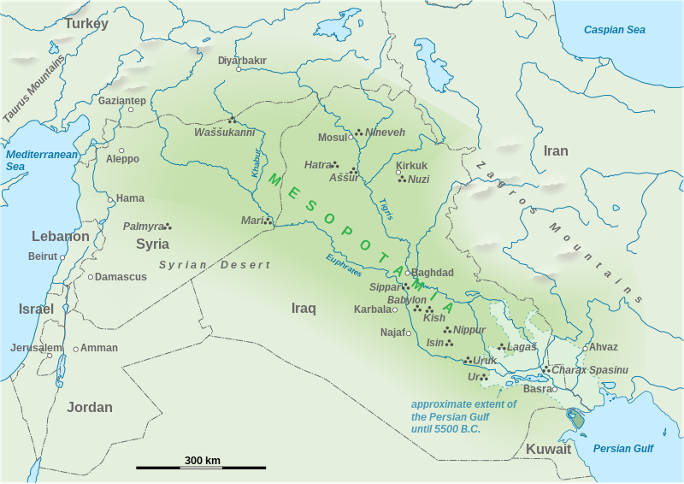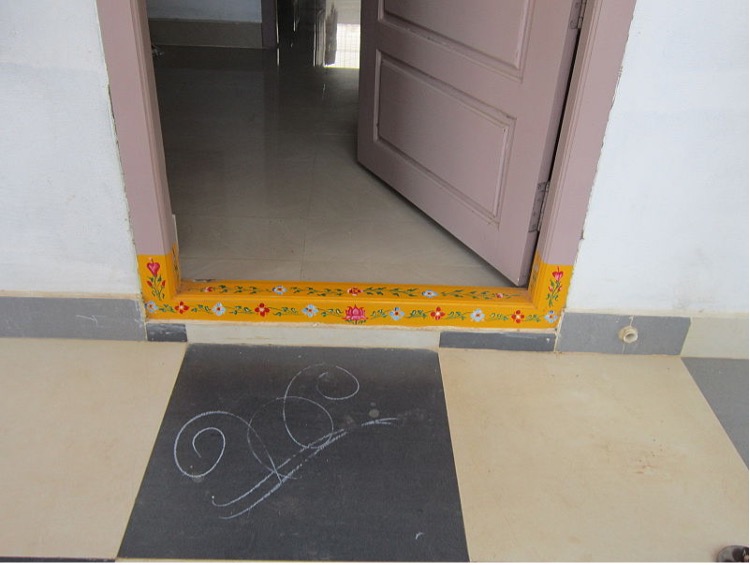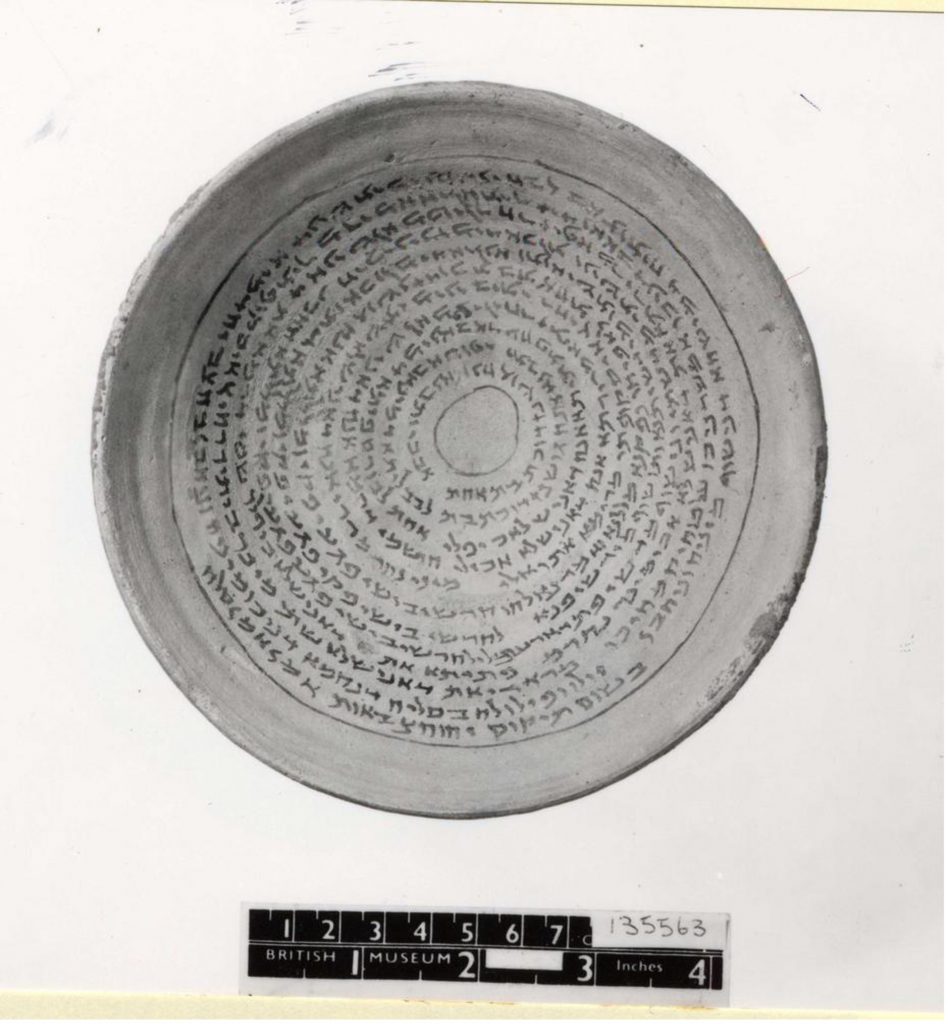- A guest post by Anne Sieberichs
Introduction
The Aramaic Incantation bowls, produced between the fifth and the eighth centuries CE, prove to be an interesting case study, demonstrating the importance of both the visual characteristics of ancient sources and their written content. In art history, archeology, and/or history, one tends to focus on either materiality or textual content. When considering a written object, one cannot understand its true nature if one ignores its materiality and use. As beautifully stated by Daniel Miller (2009: preface), “things make us as much as we make things”. Consequently, objects can have a social life on their own and influence the human subject (Ireland & Lydon 2016: 2). The combination of the materiality of an object and its written content is thus important when we want to analyse a material object as such. Take for instance the difference between a physical book and an e-book. Both can contain the same kind of written content, but it is the difference of materiality that creates a significant distinction between the two, both in use and feeling.
In this post, I will illustrate the entanglements of the use of the incantation bowls and their text through the concept of liminality that is present in both the text and its use. More specifically, I will look at the placement of the bowls within thresholds, and how they served as a second wall providing protection inside against the non-protected outside, using bowl CAMIB 49A as an example.
The Incantation Bowls
The Aramaic Incantation bowls can be defined as ‘magic texts’ that are written on earthenware bowls, approximately the size of a cornflakes bowl (e.g., 15.9 cm in diameter and 6.8 cm in depth for the CAMIB 49A bowl). The bowls are found in, and were therefore probably mainly produced in, Mesopotamia (modern Iraq). The content, as well as the dialects in these bowls are extremely varied, as they are concerned with the protection of many different people and households with different purposes. The bowls are written in several dialects of the Aramaic language (e.g., Jewish Aramaic, Syriac and Mandaic), and some are written in pseudo-script – that is, they do not say anything, but imitate Aramaic writing. As mentioned, the bowls were primarily produced during the sixth and seventh centuries CE, but some authors argue that the practice began earlier. They may have continued to be produced until the early eighth century CE (Shaked et al 2013: 1).

The content of these bowls demonstrates that they were used in rituals, and that they were commissioned with specific goals in mind, which might be protection or cursing. The materiality of a bowl allows for different uses than, for instance, a small metal or papyrus amulet which could be carried (Shaked et al. 2013: 1). Instead, the bowls were used in a “stationary position”, most often buried upside down under the ground, either under thresholds or in the four corners of a house. This ritual practice, in combination with the magical connotations that these bowls have nowadays, raises the question of how this went hand in hand with the religions of the time, such as Judaism, Christianity, and Mandaism. The opposition to magic of these religions did not prevent their members from writing and using these incantation texts. This use may have been justified by the language used by these bowls: Shaked et al. describe how: “they avoided terminology such as “magic” or “witchcraft” when describing their practices and called their texts by a variety of appellations which implicitly rejected any imputation of sorcery. […] Adherents of these religions would rather speak of amulets, invocations, healing and protection.” (Shaked et al. 2013: 2-3) Or, as stated by Michael G. Morony (2007: 426), “the practices contained in the texts under discussion here were not considered to be magic by those who performed them but to be pious acts of invoking holy names to achieve positive aims”.
One might argue that the word “magic” should not be used to describe these bowls, as this is a rather loaded term for something that was not considered as such at the time of their production. Alternatively, one could argue that these bowls were a part of a ritualistic environment that invoked supernatural entities to achieve certain aims, which is not inherently connected to the loaded term of “magic”.
Liminality
The concept of liminality is closely connected to ritual and was elaborately defined and theorized by the anthropologist Victor Turner. Turner defines the “liminal” state as a transition in which someone or something “passes through a cultural realm that has few or none of the attributes of the past or coming state.” (Turner 1969: 94) As a consequence, being in this state results in the fact that the person or object slips through existing classifications. (Turner 1969: 95) Unsurprisingly, liminality goes hand in hand with ritual, which is often characterised by marking these past or coming states. The ritual thus often demarcates being on this threshold of something old and something new and emphasises this liminal state. The incantation bowls also stand in between two phases, depending on their aim, for instance, a state of non-protection and a state of protection, suggesting a relationship to liminality. But how does this express itself within the use of the bowls and their content?
Materiality and written content
As briefly stated before, the incantation bowls were often found buried underneath the threshold of a house – the liminal space between inside and outside – illustrating the protective nature the bowl carried, which demarcated the threshold between protection and its absence. As such, the bowl is situated in what one may call ‘spatial liminality’. Liminality in general is already a highly spatial concept, as it describes something situated in between two opposed sides. Therefore, the concept is also useful when considering space and conceptualising borders and boundaries and their uses (Thomassen 2014: 91). These bowls and other objects used for incantations, such as objects containing love spells or curses, were often placed under these thresholds for a specific goal, on the principal that they needed to ‘touch’ the person they were intended to affect. As noted by Ortal-Paz Saar, a simple way to establish contact between the object and the intended person, while maintaining relative secrecy, was to bury the object at a place where the person arrived and left every day, the threshold of a home (Saar 2017: 99). Consequently, the fact that these bowls are used to demarcate these borders tells us something about how important borders were in the use of these bowls, and that liminality is an important concept to understand this ritual use. Emilie M. Van Opstall’s work Sacred Thresholds: The Door to the Sanctuary in Late Antiquity (2018: 1-2) describes how entering a place can generate emotional, religious, and imaginative experiences, and even mystical rapture. The threshold of being both in between a sacred and non-sacred space, such as a cathedral, marks the liminal stage of this experience. The presence of these bowls under thresholds could thus create a feeling of protection and the divine through spatial liminality for those who know the bowl is there when they enter.

That liminality was a concept used in this practice also becomes clear when we consider the written content. Given the scope of this article, I will limit myself to bowl CAMIB 49A, also known as bowl BM 135563. The content of this specific bowl shows the importance of a secure house and the significance of a threshold to provide this security by placing it beneath it. The text begins:
“By my door I sit, I, Gusnazdukt daughter of Ahat; the Babylonian (spell) I cast. In the rubbish I sit, I Gusnazdukt daughter of Ahat; the (spell) of Borsippa I cast into the crumbling earth, I whom no-one restrains.”
(Segal 2000; Müller-Kessler & Kwasman 2000: 159-165; Morgenstern 2004: 207-222; Müller-Kessler & Kwasman, 2012: 189-198)
The incantation bowl is concerned with the protection of its client, named Gušnazdukht (גושנזדוכת), from sorcery and demons. It thus shows not only how the bowl is placed by the door, but also how it speaks the words of protection of the client within this threshold. The text repeats “My house is secure, my threshold high” twice (see for the full editions and translations Segal, 2000; Müller-Kessler & Kwasman, 2000: 159-165; Morgenstern 2004: 207-222; Müller-Kessler & Kwasman 2012: 189-198). Both instances illustrate the importance that place and spatial liminality had in the ritual of these bowls. The connotations related to thresholds – feeling that one is in between two worlds, and thus experiencing certain sensations related to wonder, aesthetic enjoyment or mystical rapture, as noted by van Opstall (2018: 2) – may have also been a significant factor in the placement of these bowls within the thresholds of a home. While we cannot be certain what emotions were connected to these bowls, the importance of thresholds and these liminal spaces specifically in the setting of the home cannot be denied, considering that these were places where people were bound to step in when entering the place. In doing so, the practitioner could ensure that the bowl came into contact with the beneficiary of the ritual act, and the object was able to exert its power (Saar 2017). Van Opstall talks about the thresholds of sacred spaces, which could invoke special experiences, while the bowls were placed in the setting of a home, a very common place to cross every day. These places would thus not invoke feelings of mystic wonder, but this liminality woule still have initiated the feeling of protection for the individual who crossed the border between protection and its absence.
Conclusion
Think about returning to your own house and having a safe feeling of coming home. Normally, it is here where we have created our own space, separated from the outside world. While it is not sacred an sich, it can still evoke some special feelings of cosiness and homeliness that cannot be found elsewhere. The incantation bowls would be a significant addition to this feeling of safeness when entering one’s own space, and their relationship to liminality and thresholds plays a significant factor in enhancing such a feeling.
This article has explored a few of the various ways in which the incantation bowls of Mesopotamia could be interpreted by briefly applying the concept of (spatial) liminality to these bowls. These bowls also demonstrate many other instances of liminality, considering that they also often write about two extremes, such as life and death and good and evil, but here we have shown the importance of the placement of these bowls within a specific threshold to create this moment of contact between the bowl as an object and the target of its protection. As such, liminality can be used as a further means to gain a deeper understanding of these bowls and their connection to ritual and the place of liminality within this ritual. CAMIB 49A, in particular, shows how the bowl can be interpreted as being a second wall that surrounds the household for security and protection. And a protective wall as such is always watching two sides, protecting the good against the possible evil.
Bibliography
Ireland, Tracy, and Jane Lydon, “Rethinking Materiality, Memory and Identity,” in Public History Review, vol. 23 (2016): 1-8.
Miller, Daniel. Stuff. Cambridge: Polity Press, 2010.
Morgenstern, Matthew. “Notes on a Recently Published Magic Bowl,” in Aramaic Studies 2.2 (2004): 207-222.
Morony, Michael G. “Religion and the Aramaic Incantation Bowls,” in Religion Compass 1/4 (2007): 414-429.
Müller-Kessler, Christa, and Theodore Kwasman. “A Unique Talmudic Aramaic Incantation Bowl,” in Journal of the American Oriental Society, Vol. 120, No. 2 (2000): 159-165.
Müller-Kessler, Christa, and Theodore Kwasman. “Once Again on the Unique Incantation Bowl BM 135563,” in Journal of the American Oriental Society, Vol. 132, No. 2, (2012): 189-198.
Opstall, Emilie M. van. Sacred Thresholds: The Door to the Sanctuary in Late Antiquity. Leiden: BRILL, 2018.
Saar, Ortal-Paz. “Making Love, Making Hate: Practices of Jewish Love Magic,” in Jewish Love Magic: From Late Antiquity to the Middle Ages. Leiden/Boston: Brill, 2017.
Shaked, Shaul, and James Nathan Ford, and Siam Bhayro. Aramaic Bowl Spells: Jewish
Babylonian Aramaic Bowls, Volume One. Leiden: Brill, 2013.
Segal, Judas B. Catalogue of the Aramaic and Mandaic Incantation Bowls in the British Museum (CAMIB), no. 49A. London: BMP, 2000.
Thomassen, Bjorn. Liminality and the Modern: Living Through the In-between. Ashgate, 2014.
Turner, Victor. “Liminality and Communitas,” in The Ritual Process: Structure and Anti-Structure. Chicago: Aldine Publishing Company, 1969.
Anne Sieberichs is currently a Research Masters student of Ancient, Medieval and Renaissance Studies at Utrecht University. Her research focuses mainly on early mediaeval, Merovingian hagiography and monastic communities. However, during her BA cultural studies at Tilburg University, she was also actively studying and translating Biblical Hebrew. Anne is now active as a master-apprentice for Ortal-Paz Saar. For this apprenticeships, she is working on the Aramaic incantation bowls. She is providing a helping hand in inputting information on incantation bowls into the Kyprianos database.

